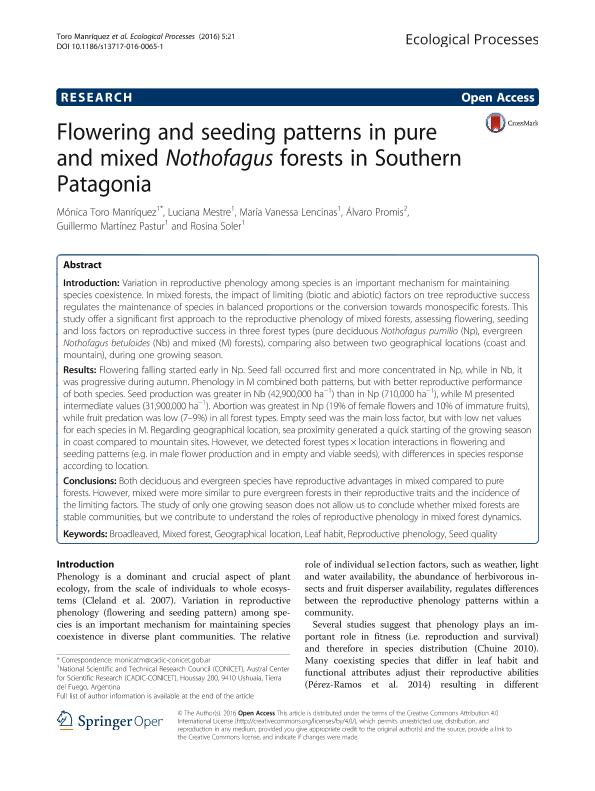Mostrar el registro sencillo del ítem
dc.contributor.author
Toro Manríquez, Mónica del Rosario

dc.contributor.author
Mestre, Luciana Mariel

dc.contributor.author
Lencinas, María Vanessa

dc.contributor.author
Promis Baeza, Alvaro Andres

dc.contributor.author
Martínez Pastur, Guillermo José

dc.contributor.author
Soler Esteban, Rosina Matilde

dc.date.available
2018-08-15T16:13:45Z
dc.date.issued
2016-12
dc.identifier.citation
Toro Manríquez, Mónica del Rosario; Mestre, Luciana Mariel; Lencinas, María Vanessa; Promis Baeza, Alvaro Andres; Martínez Pastur, Guillermo José; et al.; Flowering and seeding patterns in pure and mixed Nothofagus forests in Southern Patagonia; Springer Verlag Berlín; Ecological Processes; 5; 1; 12-2016; 1-12
dc.identifier.issn
2192-1709
dc.identifier.uri
http://hdl.handle.net/11336/55628
dc.description.abstract
Introduction: Variation in reproductive phenology among species is an important mechanism for maintaining species coexistence. In mixed forests, the impact of limiting (biotic and abiotic) factors on tree reproductive success regulates the maintenance of species in balanced proportions or the conversion towards monospecific forests. This study offer a significant first approach to the reproductive phenology of mixed forests, assessing flowering, seeding and loss factors on reproductive success in three forest types (pure deciduous Nothofagus pumilio (Np), evergreen Nothofagus betuloides (Nb) and mixed (M) forests), comparing also between two geographical locations (coast and mountain), during one growing season. Results: Flowering falling started early in Np. Seed fall occurred first and more concentrated in Np, while in Nb, it was progressive during autumn. Phenology in M combined both patterns, but with better reproductive performance of both species. Seed production was greater in Nb (42,900,000 ha−1) than in Np (710,000 ha−1), while M presented intermediate values (31,900,000 ha−1). Abortion was greatest in Np (19% of female flowers and 10% of immature fruits), while fruit predation was low (7–9%) in all forest types. Empty seed was the main loss factor, but with low net values for each species in M. Regarding geographical location, sea proximity generated a quick starting of the growing season in coast compared to mountain sites. However, we detected forest types × location interactions in flowering and seeding patterns (e.g. in male flower production and in empty and viable seeds), with differences in species response according to location. Conclusions: Both deciduous and evergreen species have reproductive advantages in mixed compared to pure forests. However, mixed were more similar to pure evergreen forests in their reproductive traits and the incidence of the limiting factors. The study of only one growing season does not allow us to conclude whether mixed forests are stable communities, but we contribute to understand the roles of reproductive phenology in mixed forest dynamics.
dc.format
application/pdf
dc.language.iso
eng
dc.publisher
Springer Verlag Berlín

dc.rights
info:eu-repo/semantics/openAccess
dc.rights.uri
https://creativecommons.org/licenses/by/2.5/ar/
dc.subject
Broadleaved
dc.subject
Geographical Location
dc.subject
Leaf Habit
dc.subject
Mixed Forest
dc.subject
Reproductive Phenology
dc.subject
Seed Quality
dc.subject.classification
Agricultura

dc.subject.classification
Agricultura, Silvicultura y Pesca

dc.subject.classification
CIENCIAS AGRÍCOLAS

dc.title
Flowering and seeding patterns in pure and mixed Nothofagus forests in Southern Patagonia
dc.type
info:eu-repo/semantics/article
dc.type
info:ar-repo/semantics/artículo
dc.type
info:eu-repo/semantics/publishedVersion
dc.date.updated
2018-08-15T14:23:41Z
dc.journal.volume
5
dc.journal.number
1
dc.journal.pagination
1-12
dc.journal.pais
Alemania

dc.journal.ciudad
Berlín
dc.description.fil
Fil: Toro Manríquez, Mónica del Rosario. Consejo Nacional de Investigaciones Científicas y Técnicas. Centro Austral de Investigaciones Científicas; Argentina
dc.description.fil
Fil: Mestre, Luciana Mariel. Consejo Nacional de Investigaciones Científicas y Técnicas. Centro Austral de Investigaciones Científicas; Argentina
dc.description.fil
Fil: Lencinas, María Vanessa. Consejo Nacional de Investigaciones Científicas y Técnicas. Centro Austral de Investigaciones Científicas; Argentina
dc.description.fil
Fil: Promis Baeza, Alvaro Andres. Universidad de Chile; Chile
dc.description.fil
Fil: Martínez Pastur, Guillermo José. Consejo Nacional de Investigaciones Científicas y Técnicas. Centro Austral de Investigaciones Científicas; Argentina
dc.description.fil
Fil: Soler Esteban, Rosina Matilde. Consejo Nacional de Investigaciones Científicas y Técnicas. Centro Austral de Investigaciones Científicas; Argentina
dc.journal.title
Ecological Processes
dc.relation.alternativeid
info:eu-repo/semantics/altIdentifier/url/http://ecologicalprocesses.springeropen.com/articles/10.1186/s13717-016-0065-1
dc.relation.alternativeid
info:eu-repo/semantics/altIdentifier/doi/http://dx.doi.org/10.1186/s13717-016-0065-1
Archivos asociados
